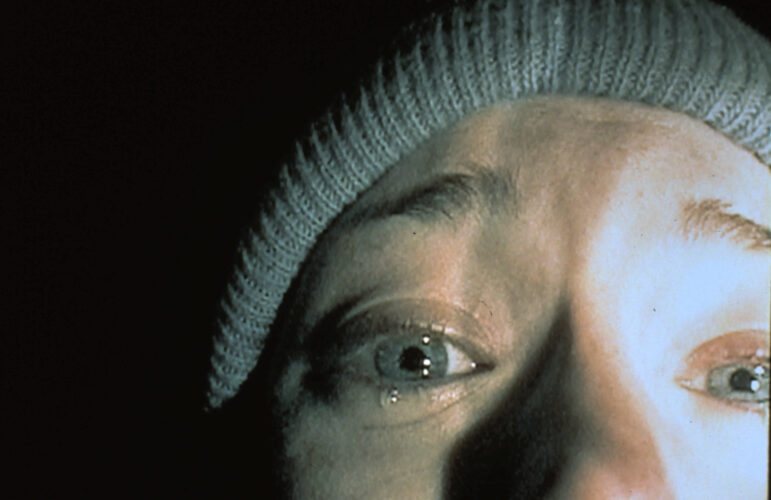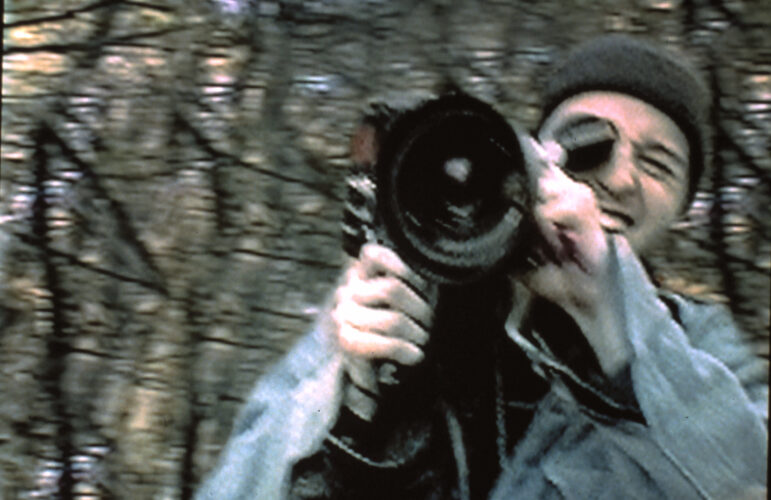
“Witches in days gone by were roasted just like my Vienna sausage.”
In 1999, the first film ever to be marketed primarily online scared and sickened audiences with shaky-cam motion sickness, the classic trope of being lost in the woods, and the terror of a friend facing a corner and acting weird.
Horror movies would never be the same.
Even a person who has never seen Daniel Myrick and Eduardo Sánchez’s found-footage film The Blair Witch Project are familiar with its visual language and fresh approach to movie-making. Imitated and parodied in the intervening decades, it’s still a landmark in the strange country of horror.
It’s also a movie about Witchcraft, buried to the hilt in unspoken allusions to Appalachian folk magic, the legacy of the executions in Salem, and the American psychic connection to witches. The titular character of the film is never shown, only pursued and speculated upon.
So what does this film mean to a Witch today?

The famous shot of Heather Donahue in “The Blair Witch Project” (1999) [Artisan Entertainment]
Viewers are introduced to Heather Donahue, Michael C. Williams, and Joshua Leonard (all three actors appeared under their real names) as missing students whose footage has been discovered after their disappearance. In the beginning, it’s all weenie roast jokes and the silly camaraderie of college students out for a whimsical woodland tour. But soon, creeps abound: stories of a serial murderer of children and an old woman whose feet never touch the ground come to them from locals, who also mention vague signs sometimes found in these very woods. Of course, the signs appear: a cairn, stones piled up in a tree like fossilized eggs, and the crude figure of a man made from sticks and bound with hairy twine.
No surprise when the teens’ fun is spoiled by gore and bumps in the night; that’s what a horror movie is for. It’s a good one mostly for what it does not show. Moviegoers were left in unresolved disquiet in 1999, when the climax of the film showed only an unresponsive Mike standing in the corner of an abandoned house, not turning when his friends scream his name. The magic and mayhem of this film is just out of sight at all times, moving in darkness and half-glimpsed oddities, screaming from somewhere deep in the night.
To be a Witch is to be the subject of rumor. I remember when this film premiered the recurrence of a feeling I had not experienced since the late 1980s, when I was living in a Midwestern town utterly gripped by the old Satanic Panic. The Blair Witch Project succeeded for a number of reasons. It undercut expectations with its low-budget camcorder aesthetic. It plumbed the American paranoia about the figure of the Witch, which is always just out of sight, in the woods, full of secrets, full of danger. It kept that paranoia firmly located in the same neighborhoods as true crime and unexplained phenomena, two gold mines to capture the imagination. It used the internet with the unerring instinct of the digital native who knows what makes content irresistible. Most importantly: it did not show too much.
Rumors of Witches in the woods, in some other town, or hidden in plain sight, are part of our history. The Book of Shadows attributed to Lady Sheba advises anyone asked about the existence of Witches to play the fool. “If any person, not in the magic circle, speak of the Craft say, ‘Speak not to me of such, it frightens me.’” This advice is not only intended to distance the respondent from the idea of Witchcraft, but to increase the power of the rumor. To even speak of such things is too much a scare to continue.
Rumors were all many Witches had to go on in 1999. Many practitioners had no local contacts at all, and few prospects of meeting any outside of metaphysical bookshops or the early iterations of Pagan Pride gatherings. Like The Blair Witch Project, the modern Pagan movement caught on because of people who knew how to use the internet. Beginning with sites like 1997’s The Witches’ Voice (Witchvox) and Isaac Bonewits’ neopagan.net, practitioners emerged from rumor and into one another’s chat rooms. Instead of wandering in the woods, armed with satanic stories and hopes for a wild Beltane, Witches all over the world had a way to connect that was mostly safe for the first time.
There is no safety in The Blair Witch Project. Josh is abducted from his friends’ camp, and reappears only in a bound-stick bundle of severed tongue and fingers and pulled teeth left on the doorstep of one of their tents. The teens blunder deeper and deeper into the Maryland wilderness until there is no escape. What pursues them has no form to fight and no shape to banish, even if these kids knew how. We know from the first moment, from the fact that we’re viewing found footage, that they’re not coming back.

Still of Joshua Leonard holding a camera in “The Blair Witch Project” (1999) [Artisan Entertainment]
The internet Witches of the 1990s wanted to be different from the Blair Witch. They wanted to be firmly separated from Satanism. They wanted to be safe, assimilated, and accepted by the culture at large, and so they constantly positioned themselves as normal people who would harm none. They pointed out the wicked sisters of Oz and the butcher of Burkittsville, MD, and said they not like us. They held up quaint suburban Samantha and the sexy Owens oopsie-killers and said “let us sit on your interfaith board; we promise we don’t bite.”
Twenty-five years later, my favorite thing about The Blair Witch Project is that the Witch does bite. The magic is secret and nobody talks too much. The horror is implacable, and the offering is written in a language the viewer is not meant to read. It’s not about Wicca, as the incompetent sequel Book of Shadows: Blair Witch 2 makes clear by including a totally useless Wiccan character who disappears immediately.
It’s about a casual use of the word “coven” where you’re not sure if someone means Witches, vampires, or those old people in Rosemary’s Baby. (Yes, we’re coming to that one. Please stay tuned.) It’s about the kind of Witch rumored to exist somewhere so wild and so beyond the laws of man that we can’t even speak of her — we don’t even know her real name. It’s about the way the unprepared should never approach the circle, and a reminder that it would be better to just rush upon this blade and get it over with.
She’s not like us. The Blair Witch will never die.
“The Blair Witch Project” is available for streaming on Prime Video and Google Play.
The Wild Hunt is not responsible for links to external content.
To join a conversation on this post:
Visit our The Wild Hunt subreddit! Point your favorite browser to https://www.reddit.com/r/The_Wild_Hunt_News/, then click “JOIN”. Make sure to click the bell, too, to be notified of new articles posted to our subreddit.